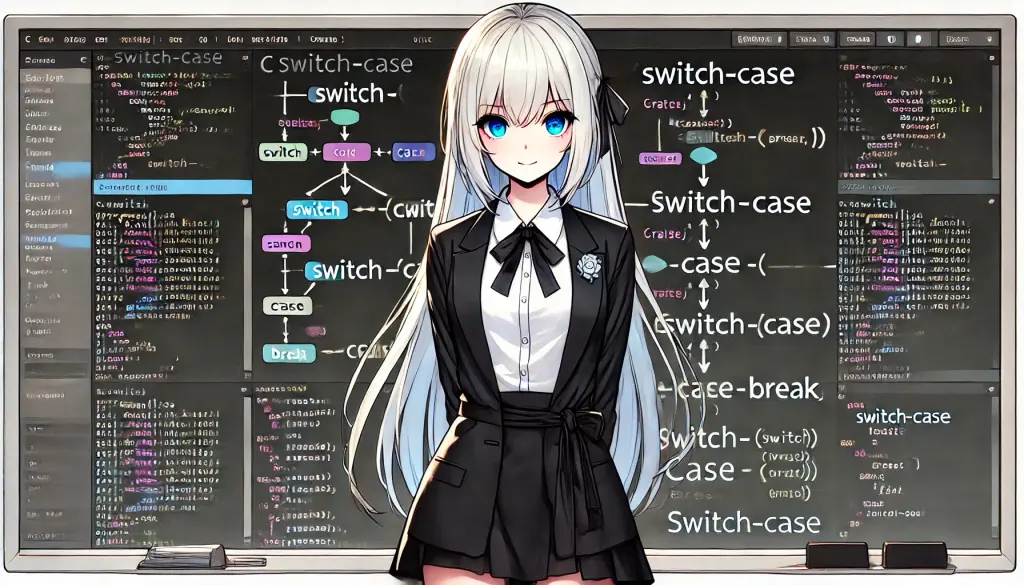- 1 1. Introduction: What is Conditional Branching in C?
- 2 2. Basic Syntax and Usage of switch-case
- 3 3. Features and Precautions of switch-case
- 4 4. Choosing Between if-else and switch-case: Which Should You Use?
- 5 5. Advanced Usage: Making switch-case More Convenient
- 6 6. Common Errors and Fixes
- 7 7. Summary and Next Steps
1. Introduction: What is Conditional Branching in C?
The Importance and Role of Conditional Branching
In programming, conditional branching plays a critical role. By executing different processes depending on specific conditions, you can improve the flexibility and efficiency of a program.
Basics of Conditional Branching in C
In the C language, there are mainly two ways to implement conditional branching:
- if-else statement
- switch-case statement
Among these, the switch-case statement is especially effective when there are multiple clear options, as it can handle them more efficiently.
Role and Use Cases of switch-case
The switch-case statement is a control structure that branches execution based on the value of a specific variable. It is useful in scenarios such as:
- Menu selection programs
- Classification based on numbers or characters
- Simple state management
Example of a Use Case
For example, imagine an application that performs different actions depending on a menu number. If the user selects “1”, the program executes “Start”. If the user selects “2”, the program executes “Exit”.
Benefits of Learning switch-case
- Concise code with improved readability
- Clearly organized branching logic reduces errors
- Improves overall program efficiency
In this article, we will cover the basics of the switch-case statement, practical examples, and important tips. By the end, you will have a deeper understanding of conditional branching in C and gain practical coding skills.

2. Basic Syntax and Usage of switch-case
Basic Syntax
Here is the basic syntax of a switch-case statement:
switch (expression) {
case CONSTANT1:
// process 1
break;
case CONSTANT2:
// process 2
break;
default:
// default process
}Code Example: Day of the Week Program
#include <stdio.h>
int main() {
int day;
printf("Enter a number for the day of the week (1-7): ");
scanf("%d", &day);
switch (day) {
case 1:
printf("Monday\n");
break;
case 2:
printf("Tuesday\n");
break;
case 3:
printf("Wednesday\n");
break;
case 4:
printf("Thursday\n");
break;
case 5:
printf("Friday\n");
break;
case 6:
printf("Saturday\n");
break;
case 7:
printf("Sunday\n");
break;
default:
printf("Invalid input\n");
}
return 0;
}Key Points in This Example
- Each
caseincludes abreakstatement to control the program flow properly. - The
defaultcase handles invalid input safely.
Advantages of Using switch-case
- Improved readability: The branching logic is simple and easy to follow.
- Reduced code size: Efficiently handles multiple conditions for the same variable.
- Error prevention: Easily incorporate fallback logic for unexpected inputs.
3. Features and Precautions of switch-case
Feature 1: Simple and Readable
The switch-case statement makes multiple branches concise, which improves code readability.
Feature 2: Specialized for Integers and Characters
The switch-case statement is designed specifically to handle integer (int) and character (char) values.
Precautions When Using
1. Don’t Forget break Statements
int num = 1;
switch (num) {
case 1:
printf("One\n");
case 2:
printf("Two\n");
default:
printf("Other\n");
}Output:
One
Two
OtherCorrected Version:
int num = 1;
switch (num) {
case 1:
printf("One\n");
break;
case 2:
printf("Two\n");
break;
default:
printf("Other\n");
}2. Only Constants Are Allowed
int x = 10;
switch (x) {
case x: // Error
printf("Error\n");
break;
}Corrected Version:
#define VALUE 10
switch (x) {
case VALUE:
printf("Success\n");
break;
}Summary
- Always include break statements – Prevents unintended fall-through.
- Use only constants – Variables or expressions are not allowed.
- Organize nested structures – Maintain readability with proper comments and indentation.

4. Choosing Between if-else and switch-case: Which Should You Use?
Basic Differences
1. How Conditions Are Evaluated
- if-else evaluates logical expressions (comparisons, ranges, multiple conditions, etc.).
- switch-case evaluates whether a specific value (constant or character) matches.
Comparison Table
| Comparison Item | if-else | switch-case |
|---|---|---|
| Condition Expression | Can handle logical expressions or ranges | Limited to specific integer or character values |
| Readability | Becomes harder to read with complex conditions | Easy to read with explicitly defined cases |
| Performance | May be slower in some cases | Often optimized by the compiler for faster execution |
| Extensibility | Flexible for adding conditions | Limited since only constants are allowed |
| Best Use | Effective for ranges or complex conditions | Best for fixed options like menu selections |
Practical Examples
Example with if-else:
int score = 85;
if (score >= 90) {
printf("Excellent\n");
} else if (score >= 70) {
printf("Good\n");
} else {
printf("Fair\n");
}Example with switch-case:
int grade = 2;
switch (grade) {
case 1:
printf("Excellent\n");
break;
case 2:
printf("Good\n");
break;
case 3:
printf("Fair\n");
break;
default:
printf("Fail\n");
}5. Advanced Usage: Making switch-case More Convenient
1. Combine Multiple Cases
char grade = 'A';
switch (grade) {
case 'A':
case 'B':
printf("Pass\n");
break;
case 'C':
printf("Retake\n");
break;
default:
printf("Fail\n");
}2. Use Fall-through Intentionally
int score = 85;
switch (score / 10) {
case 10:
case 9:
printf("Excellent\n");
break;
case 8:
case 7:
printf("Good\n");
break;
default:
printf("Fail\n");
}3. Nested switch-case
int menu = 1;
int subMenu = 2;
switch (menu) {
case 1:
switch (subMenu) {
case 1:
printf("Submenu 1-1\n");
break;
case 2:
printf("Submenu 1-2\n");
break;
}
break;
case 2:
printf("Menu 2\n");
break;
}6. Common Errors and Fixes
1. Forgetting break Statements
int num = 1;
switch (num) {
case 1:
printf("One\n");
case 2:
printf("Two\n");
default:
printf("Other\n");
}Fix:
int num = 1;
switch (num) {
case 1:
printf("One\n");
break;
case 2:
printf("Two\n");
break;
default:
printf("Other\n");
}2. Using Variables in case Labels
int x = 10;
switch (x) {
case x: // Error
printf("Value is 10\n");
break;
}Corrected Version:
#define VALUE 10
switch (x) {
case VALUE:
printf("Success\n");
break;
}3. Omitting the default Case
int num = 5;
switch (num) {
case 1:
printf("One\n");
break;
case 2:
printf("Two\n");
break;
}Fix:
switch (num) {
case 1:
printf("One\n");
break;
case 2:
printf("Two\n");
break;
default:
printf("Other\n");
}
7. Summary and Next Steps
1. Key Takeaways
- Basic Syntax and Usage
- The
switch-casestatement is a useful control structure for branching based on specific values. - It is simple, readable, and effective for handling clearly defined conditions.
- Features and Precautions
switch-caseonly works with integer or character constants.- Forgetting
breakcan cause unintended fall-through, so proper syntax is essential.
- Choosing Between if-else and switch-case
- if-else is better for ranges and complex conditions, while switch-case is best for fixed-value branching.
- Using them appropriately improves program efficiency.
- Advanced Techniques
- Combine multiple cases, use fall-through for range checks, and nest switch statements when needed.
- Integrating with functions and structures helps organize more complex programs.
- Common Errors and Fixes
- We covered common mistakes such as missing
breakstatements and invalidcaselabels, along with their solutions. - Understanding these fixes helps reduce debugging time.
2. Next Steps
1. Build Practical Programs
Apply what you learned by creating programs such as:
- Calculator: Handle arithmetic operations with
switch-case. - Menu selection app: Implement multi-level menus.
- Grade management system: Classify results automatically.
2. Learn Related Topics
To expand your use of switch-case, study:
- Advanced if-else: Master more conditional branching techniques.
- Loop structures (for, while): Combine iteration with conditions.
- Functions and structures: Manage large programs more efficiently.
3. Optimize and Debug
- Use debugging tools: Practice identifying and fixing errors quickly.
- Code reviews: Share code with peers to get feedback and deepen your understanding.
3. Final Thoughts
The switch-case statement is a powerful tool for optimizing conditional branching in C. By mastering both the basics and advanced techniques, you can improve both readability and efficiency in your programs.
Use this guide as a reference while coding, and continue practicing with related topics to steadily level up your programming skills!



